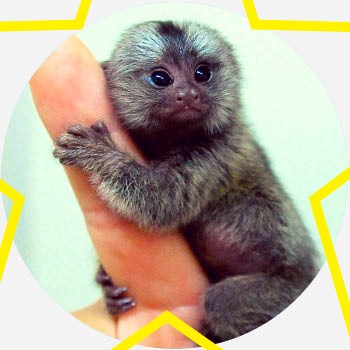What Are Finger Monkeys, its where are adorable animal videos reign supreme, finger monkeys have taken center stage. These miniature primates, also known as pygmy marmosets, are captivating hearts around the world with their petite size and charming demeanor. In this 1200-word article, we’ll dive into the intriguing world of finger monkeys, exploring their origins, characteristics, care, and the ethical aspects of keeping them as pets.

Table of Contents
What Are Finger Monkeys?
Finger monkeys, scientifically known as pygmy marmosets (Cebuella pygmaea), are among the tiniest primates on Earth. These captivating creatures are native to the lush rainforests of South America, where they dwell in the canopies of trees. Let’s embark on a journey to uncover the mysteries of these miniature marvels.
A Brief Overview of What Are Finger Monkeys
Finger monkeys, often referred to as “pocket primates,” are diminutive creatures, with an average length of just 4.6 to 6.2 inches and a weight ranging from 3 to 5 ounces. Their small size makes them truly unique in the primate world.
Native Habitat of What Are Finger Monkeys
Finger monkeys call the dense rainforests of South America home, specifically in countries like Brazil, Ecuador, Peru, and Colombia. They thrive in these tropical ecosystems, swinging from branch to branch with their incredible agility.
Size and Appearance of What Are Finger Monkeys
These miniature primates boast a distinctive appearance. With their soft fur, masked faces, and long tails, finger monkeys are easily recognizable. They are primarily gray or brown with streaks of black, and their tails are often longer than their bodies, aiding them in balance as they navigate the treetops.
What Are Finger Monkeys Behavior and Social Structure
Finger monkeys are highly social animals, living in family groups of up to 15 members. They communicate through a complex system of vocalizations, including high-pitched chirps and whistles. Their tight-knit family bonds play a vital role in their survival.
What Are Finger Monkeys Diet and Feeding Habits
Their diet consists mainly of tree sap, gum, insects, and fruits. Their specialized teeth allow them to gouge tree bark to access the sap, making them a keystone species in their ecosystem.
Finger Monkeys Diet and Feeding Habits
One of the most extraordinary features of finger monkeys is their ability to give birth to twins, which is quite uncommon in primates of their size. Additionally, they have specialized claws that aid in clinging to tree branches.
The Popularity of Finger What Are Finger Monkeys
In recent years, finger monkeys have gained immense popularity as exotic pets. Their irresistibly cute appearance and charming personalities have captivated the hearts of many, but is keeping a finger monkey as a pet a good idea?
Legal and Ethical Considerations For Finger Monkeys
Owning a finger monkey as a pet comes with a range of legal and ethical considerations. Many countries and states have strict regulations regarding the ownership of exotic animals, and these rules are in place to protect both the animals and potential owners.
Caring for a Finger Monkey
Habitat and Enclosure
Creating a suitable habitat for a finger monkey is crucial to their well-being. Mimicking their natural rainforest environment with plenty of trees and branches to swing on is essential.
Diet and Nutrition
A balanced diet that includes a variety of insects, fruits, and specially formulated monkey food is vital to ensure their nutritional needs are met.
Social Interaction
Finger monkeys thrive on social interaction, and they should not be kept in isolation. Regular interaction with their human caregivers and other finger monkeys, if possible, is essential for their mental and emotional health.
Health Concerns
Like all pets, finger monkeys can encounter health issues. Regular veterinary check-ups and a watchful eye for any signs of illness are imperative to ensure their well-being.
Training and Socialization
Proper training and socialization are essential for pet finger monkeys. Positive reinforcement techniques can help them adapt to living with humans and other animals.
Pros and Cons of Having a Finger Monkey as a Pet
Before deciding to bring a finger monkey into your home, it’s essential to weigh the pros and cons. While they are undeniably adorable and fascinating, they require a significant commitment in terms of care and attention.
Conservation Efforts for Finger Monkeys
Finger monkeys are facing threats in their natural habitat due to deforestation and illegal pet trade. Conservation efforts are underway to protect these tiny creatures and their rainforest homes.
Finger monkeys are captivating creatures that have charmed their way into the hearts of many. While they make adorable pets, their care and ownership come with significant responsibilities. Understanding their natural behavior, habitat, and the legal considerations is crucial before embarking on the journey of becoming a finger monkey caregiver.
Frequently Asked Questions
Can I legally own a finger monkey as a pet?
Ownership laws vary by location. It’s essential to research and adhere to local regulations.
How long do finger monkeys live in captivity?
With proper care, they can live up to 15 years in captivity.
Are finger monkeys endangered?
They are currently listed as a species of “Least Concern” on the IUCN Red List, but their populations are declining due to habitat loss.
Do finger monkeys require a specific diet?
Yes, they have specific dietary requirements that should be met for their well-being.
Are finger monkeys suitable for families with children?
Finger monkeys are delicate creatures and may not be suitable for households with young children.
Now that you’ve delved into the world of finger monkeys, if you’re considering having one as a pet, remember to do your research and consider the ethical aspects of ownership. These tiny primates deserve a life that is both safe and fulfilling in captivity or, preferably, in their natural rainforest homes

